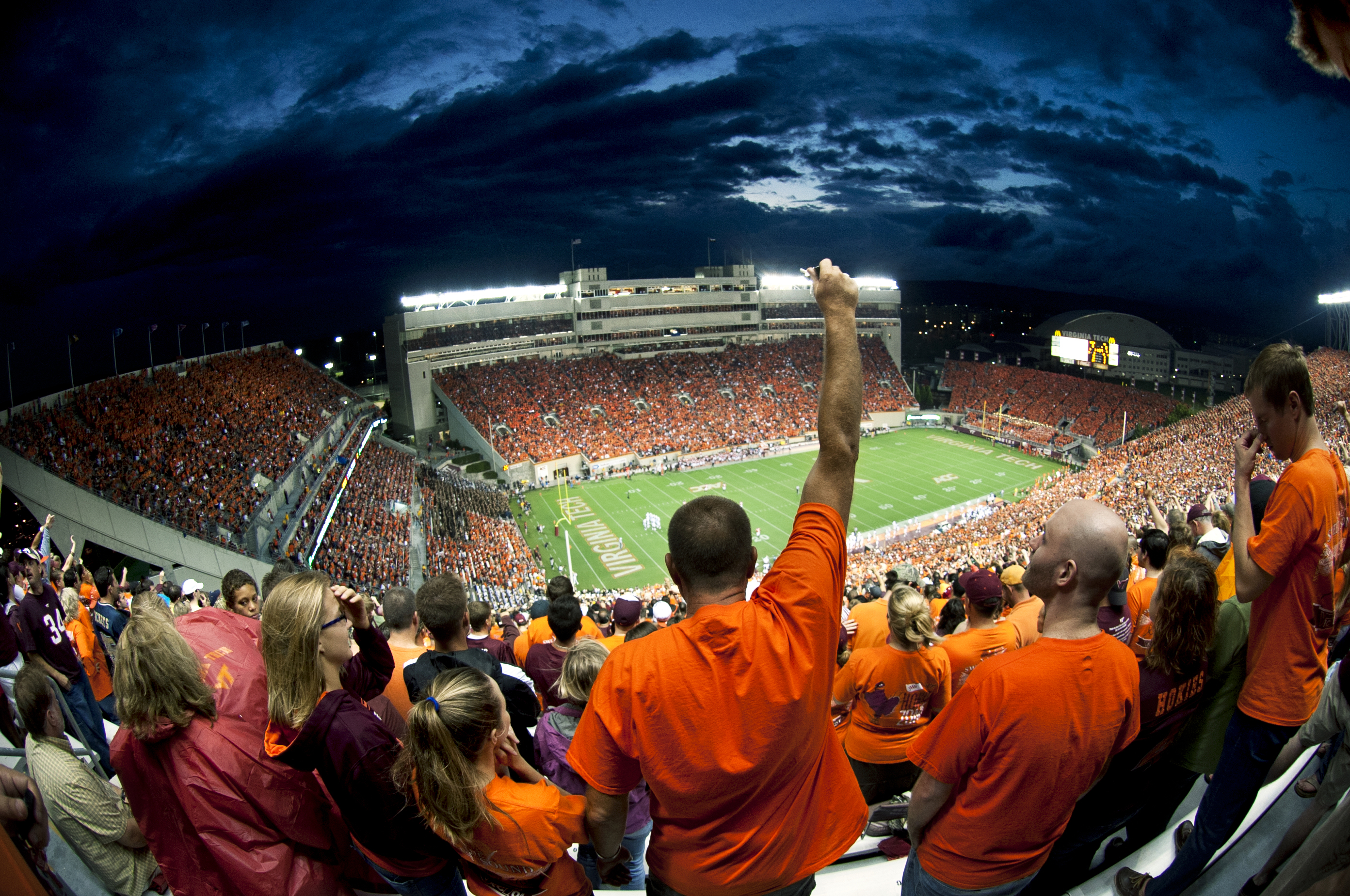Home football games bring $69 million impact, 300 jobs to region

Virginia Tech home football games draw an influx of out-of-town fans – a boon to many businesses in the region. The visiting maroon-and-orange contingent now has a dollar value: $69 million.
The annual economic impact figure comes from a Virginia Tech study that shows restaurants, hotels, and shops benefitting most from football-generated dollars spent in the region.
Football's economic impact tripled in the 15 years since the last economic impact study was done, according to the analysis. The five biggest categories where visitors dropped their dimes were hotels, restaurants, shops, grocery stores, and gas stations. Visitors' direct spending in those areas amounted to $5.9 million (hotels), $5 million (dining), $2.9 million (gasoline), $2.6 million (retail), and $2.5 million (groceries).
Virginia Tech's total football revenue amounts to $41 million. Almost three quarters of that portion, some $30 million, comes into Virginia Tech Athletics from outside the region. Most of that money – $25 million – is spent in the region.
Taxes of $1 million on all the transactions are an added benefit as well, covering sales, meals, and lodging.
"Each dollar spent has a multiplier effect as money changes hands within the region," says Sarah Lyon-Hill, economic development specialist in the Virginia Tech Office of Economic Development.
"It's important to note that our approach was conservative. Even though we excluded workers such as the dozens of security staff and police officers hired for every game-day weekend, we found that Virginia Tech football supports almost 300 jobs that wouldn't be here otherwise."
Also important to note is the reason for the study, says Larry Hincker, associate vice president for university relations, who explains that news reporters and government leaders often seek economic development data defining the university's impact.
"We have not had hard data to share, particularly about Virginia Tech sports," Hincker says. "Thus we commissioned this study, knowing that football, being the largest sport, would be the easiest to measure and would be high in public interest."
The $69 million bottom line is the sum of direct spending of $47 million plus $22 million of spending analysts call "indirect and induced," a region-specific formula that captures spillover effects into the local economy. Included in the total is the money that the Virginia Tech Athletics football program spends in the New River and Roanoke Valleys, including employee earnings of $8.6 million. Other sectors receiving boosts from football's operating costs are game security ($240,000), custodial services ($132,000), transportation ($114,000), and retail ($50,000).
"An unexpected finding was the impact on real estate," Lyon-Hill says. "Based on fan surveys, we estimate that as many as 4,700 properties may be owned by football fans from outside the region. And our survey of the real estate community showed that Realtors believe about half of those properties belong to owners who bought these homes with the intent to regularly attend home games."
In addition to analyzing the Virginia Tech Athletics budget, researchers compiled data by sending questionnaires to businesses and surveying out-of-town football fans. Season ticketholders received online surveys, complemented by in-person questioning carried out at four home-game tailgates.
The study region covered the New River and Roanoke Valleys, composed of seven counties (Giles, Pulaski, Montgomery, Roanoke, Botetourt, Franklin, and Craig) and the independent cities of Radford, Roanoke, and Salem.
Among the key findings:
- Almost three quarters of restaurants, hotels, and retail outlets say they experience an average 15 to 30 percent revenue bump during home-game weekends.
- Churches, local governments, and small nonprofit agencies benefit each game season, each organization raking in from $500 to $12,000 in parking and other fundraising activities.
- Almost all Hokie football fans value most highly "the overall game-day atmosphere," with the breakdown of favorite moments including cheering for the Hokies, enjoying the energy of the crowd, reveling in Hokie traditions, and appreciating the marching bands.
Characteristics of visiting football fans include:
- A high concentration of in-state fans are from the Richmond area as well as Northern Virginia, Hampton Roads, and Southwest Virginia.
- Out-of-state fans are clustered largely in North Carolina, with many coming from the Charlotte, Raleigh-Durham, and Greensboro areas.
- Almost half said they would not come to Blacksburg or were unsure about coming if there were no football.
- Visiting fans who miss a home game cite as their biggest excuse either family obligations or the fact that no one was available to accompany them to Lane Stadium.
Co-authors contributing to the report are Jeff Alwang, professor of agricultural and applied economics in the College of Agriculture and Life Sciences; and three graduate students in the master's of urban and regional planning program in the College of Architecture and Urban Studies: Leann Budzevski, Patrick Burke, and Adam Mawyer – all graduate research assistants in the Office of Economic Development, part of Outreach and International Affairs.




